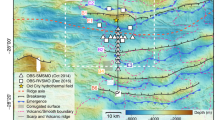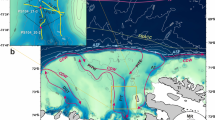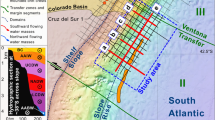Abstract
Bathymetrie profiles of most oceanic trench regions show a well-defined outer rise seawards of the trench with numerous normal faults between the trench axis and the crest of the outer rise. Several investigators (see ref. 1 for review) have shown that the gross bathymetrie features can be modelled quite well if they result from a simple mechanical bending of the subducting lithospheric plate. These results have encouraged searches for seismic evidence of the bending stresses predicted by the models. However, the available teleseismic studies2 do not determine precisely the relative depths of events on the outer rise, or the precise locations of events relative to the trench. In 1979 we successfully deployed nine ocean-bottom seismometers3 (OBS) which operated for 6 weeks on the outer trench slope in the Central Aleutians between the trench axis and the crest of the outer rise (Fig. 1). The locations, depths and focal mechanisms of the earthquakes located by this network all strongly support the bending hypothesis. In particular, we observed a band of seismicity on the outer trench slope extending ∼60 km seaward of the trench axis (Fig. 1). The shallow events (Fig. 2) exhibit normal faulting (Fig. 3) and suggest tension in the upper part of the plate, while the deeper events (Fig. 2) exhibit thrusting mechanisms and suggest compression (Fig. 3). We suggest here that low magnitude seismic activity may be a common feature associated with the well-known normal faulting on the outer trench slope.
This is a preview of subscription content, access via your institution
Access options
Subscribe to this journal
Receive 51 print issues and online access
$199.00 per year
only $3.90 per issue
Buy this article
- Purchase on Springer Link
- Instant access to full article PDF
Prices may be subject to local taxes which are calculated during checkout
Similar content being viewed by others
References
Forsyth, D. W. Rev. Geophys. Space. Phys. 19, 1109–1114 (1979).
Chapple, W. M. & Forsyth, D. W. J. geophys. Res. 84, 6729–6749 (1979).
Latham, G. V. et al. Offshore Tech. Conf. 1467–1470 (1978).
Stauder, W. J. geophys. Res. 73, 7693–7701 (1968).
Engdahl, E. R. Am. geophys. Un. Monogr.: Ewing Ser. 1, 259–271 (1977).
McAdoo, D. C., Caldwell, J. G. & Turcotte, D. L. Geophys. J. R. astr. Soc. 54, 11–26 (1978).
Caldwell, J. G. thesis, Cornell Univ. (1978).
Caldwell, J. G. & Turcotte, D. L. J. geophys. Res. 84, 7572–7576 (1979).
Nagumo, S. & Kasahara, J. Am. geophys. Un. geophys. Monogr. 19, 155–167 (1976).
Hanks, T. C. J. geophys. Res. 84, 2343–2347 (1979).
Author information
Authors and Affiliations
Rights and permissions
About this article
Cite this article
Frohlich, C., Caldwell, J., Malahoff, A. et al. Ocean bottom seismograph measurements in the Central Aleutians. Nature 286, 144–145 (1980). https://doi.org/10.1038/286144a0
Received:
Accepted:
Issue Date:
DOI: https://doi.org/10.1038/286144a0
This article is cited by
-
Evidence that biological activity affects Ocean Bottom Seismograph recordings
Marine Geophysical Researches (1981)
Comments
By submitting a comment you agree to abide by our Terms and Community Guidelines. If you find something abusive or that does not comply with our terms or guidelines please flag it as inappropriate.



